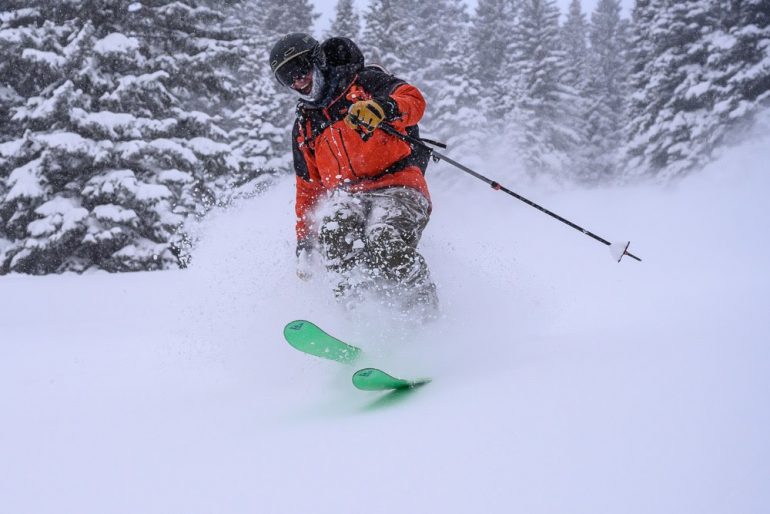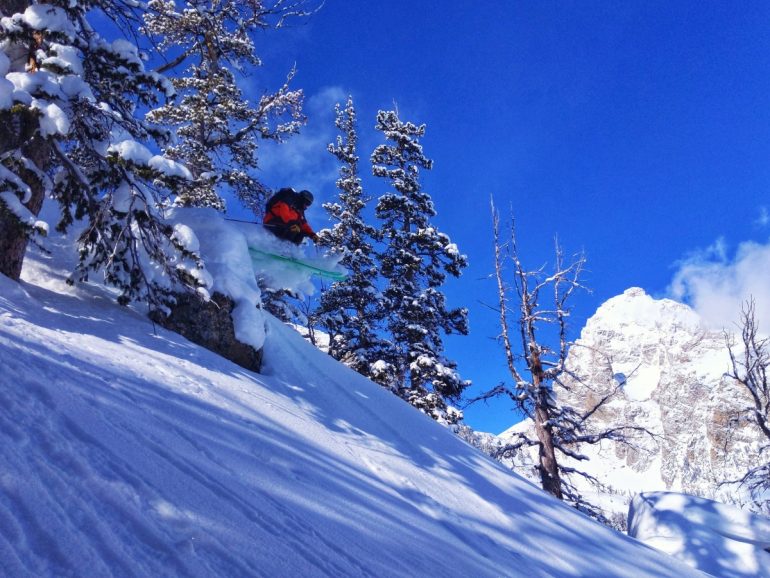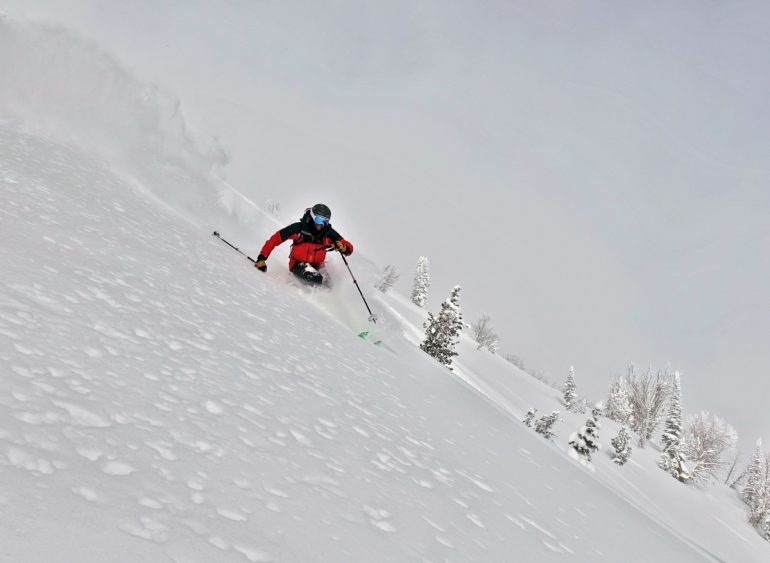Navis Freebird: all mountain touring tool
By Nate Baier
Just before we got to the transition spot on our fourth lap, Andrew turned around and yelled “10,000 feet!” Mission accomplished. The Black Crows Navis Freebirds floated effortlessly on the fresh snow, tips surfing so effortlessly, I forgot my legs were tired. We high-fived at the bottom. It was an all-time run to cap an all-time day on an exceptionally performing touring ski.
Summary: At 102 mm underfoot, the Navis Freebird is in the mid-fat range of Black Crows touring skis, sandwiched between the Ferox and Corvus and the Camox and Orb. While this ski is not skimo-race light, it is trim enough to carry up big peaks, skin all day, and still crush the backcountry and the front side. Black Crows claims versatility with this ski, and they appear to have succeeded. The skis float on powder and hold an edge on hardpack.
Ideal Pairing: With their middle of the road width and stable but snappy platform, these skis appeal to a wide spectrum of skiers, including those who want to get out for big touring missions one day and lap some resort pow the next. Depending on your binding choice you can make these a 50-50 ski or a lighter-weight big mission ski.
Sizing: Skier profile: 6′, 175 pounds, expert. I generally size my skis in the mid-180s, so the 185 cm was an easy choice. The Navis Freebird skied true to size. New for 2019, they offer an increased size range including 167 cm 173 cm, 179 cm and 185 cm.
Comparison: Comparable to the Kaestle TX98. They are similar widths (102 cm v 98 cm) and the same length (185), with shared claims of versatility. The Navis Freebird is stiffer and more stable at limit-pushing speed, whereas, the TX98 skis shorter than its length and more soft and playful for powder skiing.
Product Highlights: I am a big fan of the early rise rocker and tip of these skis. Both when skiing downhill and skinning uphill the tips always rise to the top. Stability comes by way of traditional camber underfoot and the sidewall construction. This combination allows excellent handling at speed, on hardpack and funky in conditions. The skis also offer a stiff, early rise tail to make them snappy on the turns. You can feel the stiffness when you engage your turn and roll them on their edge. The camber underfoot and flat tail allow skis gripping steep icy skin tracks.
Gripes: Deflection when skiing wet, choppy snow at the ski area, nearly inevitable with a lighter weight ski. I think this is a worthy trade off for the uphill and powder performance.
Durability: With over 100 days on these skis, I’ve put them through the ringer. Last December I hit a rock at speed resulting in a deep core shot. With p-tex in place, the board skis like nothing ever happened. Beyond the core shot, I hit a few other rocks or roots and expected core shots, but only got scrapes. Otherwise, I have only seen minor wear and tear on the topsheets.
Boots/Bindings/Skin Combination: Scarpa Maestrale RS, Fritschi Tecton, Pomoca Pro Climb 2.0
SPECS
Sizes Available: 167, 173, 179, 185 cm
Weight: 1675 gram (179 cm) per ski
Turning Radius: 19 m
Dimensions (slight variations, 179 here): 137 mm Tip, 102 mm Waist, 122 mm Tail
Core: Paulownia/Poplar
Construction: carbon and fiberglass, wood; semi-cap
MSRP: $829.95
Editor’s note: We’ve had a few other Freebird series skis in our review lineup this year, including the Camox Freebird and the Orb Freebird. Check them out.
Freebird in a Powder Paradise
Summarizing my time on the Navis Freebirds would be like trying to summarize two consecutive ski seasons. Where to begin? Early dawn patrol, Highlands Bowl laps, quick lunch tours, tours deep in the local wilderness, family “tours” pulling the kids in the burly sled, and spring lines these skis have taken me everywhere.
The skis really shined on a trip to the Tetons where my friend Andrew and I were out for big vert. Our goal was to ski 10,000 feet human powered in a single day, a long-aspired feat for both of us. As luck had it, we timed our trip with the first day of an epic 5-day cycle totalling over 4 feet of new snow. The storm came in warm with rain in town, but each day the temps got progressively cold and snow progressively airy and deep.
Day one: resort skiing. The snow was fluffy up high but heavy at the lower elevations in the afternoon. The skis kept up with changing conditions. The shovel kept the tips up in the deep and the camber underfoot keep me feeling stable when things got funky at lower elevations later in the day.
Day two: touring in Teton National Park and up Shadow Mountain. Just over 3,000 ft of climbing to the top and several inches of new snow, lighter and loftier than the day before. We linked up pillow features and open shots through the old growth White Pines, tree spacing a Colorado skier can only dream of. The stiffness of these skis are confidence inspiring when launching off features, the traditional camber underfoot allows for snappy, smooth turns through the trees.
Day three: the big day, mission 10,000 feet. Eight inches of fresh snow that stoked our excitement and snuffed the feeling of sore legs. On the last lap, snow started drifting down and I started slowing. But the skis were light underfoot and we kept trucking. Just before we got to the transition spot on our fourth lap, Andrew yelled “10,000 feet!”. Mission accomplished. The skis offered ample reward, surfing the fresh snow with such ease I forgot the leg fatigue.
Over the next two days, the snow kept dropping and the skis kept climbing. They were poppy and fun on soft pillows, and smooth and floaty in endless fluffy powder turns. Over the trip, we totaled over 30,000 feet of climbing and skiing. Days like we had in Jackson would not have been possible on one of my old setups with Marker Dukes and heavy resort skis. The Navis was up to the task of huge days and deep snow.
Is this the tool for ultra light, variable ski mountaineering missions? Maybe not, but it would hold up just as fine there as on a week-long tour of Teton pow. The hype around Black Crows is unmistakable, but so is the performance. If you want a ski climbs efficiently and unleashes on the descents, consider the Navis Freebird.
Nathan Baier is an avid backcountry skier living in Carbondale, Colorado with his wife, Kristen, and two sons. He owns his own geospatial consulting firm, Roaring Fork Geospatial, and tries to get into the backcountry as much as work and family life allow. When it is not ski season he enjoys hiking with his family and riding his mountain bike.”
Beyond our regular guest bloggers who have their own profiles, some of our one-timers end up being categorized under this generic profile. Once they do a few posts, we build a category. In any case, we sure appreciate ALL the WildSnow guest bloggers!




